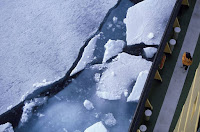The 2018 Arctic Report Card also shows sea ice reached its second-lowest extent on record, creating more challenges for coastal people and ecosystems.
On land and at sea, the Arctic is under a relentless global warming siege.
Rising temperatures, melting ice and thawing permafrost threaten ecosystems and communities across the far north with direct impacts like toxic algae outbreaks, harm to fisheries and caribou herds, and coastal erosion.
There are also indirect climate impacts that affect the rest of the world. Emerging research shows the warming Arctic drives changes to the jet stream that can result in extreme weather in North America and Eurasia, and more atmospheric moisture can fuel heavy rain storms.
The National Oceanic and Atmospheric Administration and partnering research organizations explain the impacts in the 2018 Arctic Report Card, highlighting issues like record-low sea ice in the Bering Sea and heat waves across the central Arctic.
Overall, 2018 was the second-warmest year for the Arctic since record-keeping for the region began in 1900, and the Arctic continued to warm at about twice the rate of the global average, to 3.06 degrees Fahrenheit above the 1981-2010 average. Arctic air temperatures for the past five years (2014-2018) exceeded all previous records, and Arctic sea ice extent was the second-lowest overall, with the lowest-recorded winter ice in the Bering Sea.
Read more at Arctic's Second-Warmest Year Leaves Wildlife, Communities Under Pressure

No comments:
Post a Comment